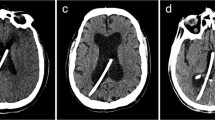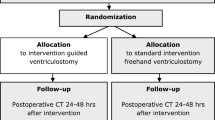Abstract
Background
Accurate ventricular catheter (VC) placement plays an important role in reducing the risk of ventriculoperitoneal shunt failure. Free-hand VC insertion is associated with a significant misplacement rate. Consequently, several expensive alternative methods that are unfortunately not available worldwide have been used. To overcome these limitations, we developed a simple surgical technique based on radio-anatomical landmarks aimed at reducing VC’s misplacements.
Method
We reproduce the preoperative imaging on the patient’s head using common anatomical landmarks. This allows defining stereotactic VC coordinates to be followed during the surgical procedure.
Conclusion
This simple and cost-effective method improves VC insertion accuracy.



Similar content being viewed by others
Abbreviations
- 2D:
-
Two-dimensional
- 3D:
-
Three-dimensional
- CP:
-
Catheter plane
- CSF:
-
Cerebrospinal fluid
- CT:
-
Computed tomography
- EAC:
-
External auditory canal
- Ep:
-
Entry point
- FOM:
-
Foramen of Monro
- Fp:
-
Frontal point
- IBO:
-
Inferior border of the orbit
- MPR:
-
Multi-planar reconstruction
- MRI:
-
Magnetic resonance imaging
- OP:
-
Oblique plane
- RP:
-
Reference plane
- Tp:
-
Target point
- VC:
-
Ventricular catheter
- VPS:
-
Ventriculoperitoneal shunt
- Ep-x:
-
x coordinate for the entry point
- Ep-x’:
-
x’ coordinate for the entry point
- Ep-y:
-
y coordinate for the entry point
- Fp-x:
-
x coordinate for the frontal point
References
Hayhurst C, Beems T, Jenkinson MD, Byrne P, Clark S, Kandasamy J, Goodden J, Nandoe Tewarie RDS, Mallucci CL (2010) Effect of electromagnetic-navigated shunt placement on failure rates: a prospective multicenter study - clinical article. J Neurosurg 113(6):1273–1278
Howard MA, Srinivasan J, Bevering CG, Winn HR, Grady MS (1995) A guide to placement of parietooccipital ventricular catheters. Technical note. J Neurosurg 82(2):300–304
Jakola AS, Reinertsen I, Selbekk T, Solheim O, Lindseth F, Gulati S, Unsgård G (2014) Three-dimensional ultrasound-guided placement of ventricular catheters. World Neurosurg 82(3–4):5–9
Kim YB, Lee JW, Lee KS, Lee KC (2006) Image-guided placement of ventricular shunt catheter. J Clin Neurosci 13(1):50–54
Levitt MR, O’Neill BR, Ishak GE, Khanna PC, Temkin NR, Ellenbogen RG, Ojemann JG, Browd SR (2012) Image-guided cerebrospinal fluid shunting in children: catheter accuracy and shunt survival: clinical article. J Neurosurg Pediatr 10(2):112–117
Lollis SS, Roberts DW (2008) Robotic catheter ventriculostomy: feasibility, efficacy, and implications. J Neurosurg 108(2):269–274
Pang D, Grabb PA (1994) Accurate placement of coronal ventricular catheter using stereotactic coordinate-guided free-hand passage. Technical note. J Neurosurg 80(4):750–755
Roth J, Constantini S (2012) Selective use of intra-catheter endoscopic-assisted ventricular catheter placement: indications and outcome. Childs Nerv Syst 28(8):1163–1169
Theodosopoulos PV, Abosch A, McDermott MW (2001) Intraoperative fiber-optic endoscopy for ventricular catheter insertion. Can J Neurol Sci 28(1):56–60
Wilson TJ, Stetler WR, Al-Holou WN, Sullivan SE (2013) Comparison of the accuracy of ventricular catheter placement using freehand placement, ultrasonic guidance, and stereotactic neuronavigation: clinical article. J Neurosurg 119(1):66–70
Author information
Authors and Affiliations
Corresponding author
Ethics declarations
Conflict of interest
The authors declare that they have no conflict of interest.
Additional information
Key points
1. Determine all reference landmarks on the preoperative exam.
2. Reproduce these landmarks on the patient’s head.
3. Keep the OP parallel to the floor.
4. Maintain CP, OP, and Ep visible after draping.
5. Insert the drain following a trajectory corresponding to the intersection between the OB and the CP.
6. Check CSF outflow until reaching the Tp.
Publisher’s note
Springer Nature remains neutral with regard to jurisdictional claims in published maps and institutional affiliations.
This article is part of the Topical Collection on CSF Circulation
Electronic supplementary material
This video illustrates the stereotactic ventricular catheter insertion technique based on radio-anatomical landmarks. (MP4 43,959 kb)
Rights and permissions
About this article
Cite this article
Bruneau, M., Spitaels, J. & Riva, M. Free-hand stereotactic ventricular catheter insertion technique based on radio-anatomical landmarks. How I do it. Acta Neurochir 163, 1097–1102 (2021). https://doi.org/10.1007/s00701-020-04549-6
Received:
Accepted:
Published:
Issue Date:
DOI: https://doi.org/10.1007/s00701-020-04549-6




